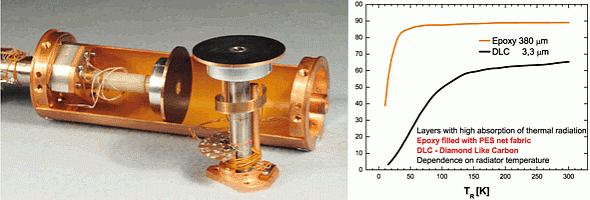Cryogenics and superconduction
The Cryogenics and Superconductivity Group started its activities in the
research and development of superconducting magnets for nuclear magnetic
resonance (NMR), including scientific and technical background for reaching and
preserving of very low temperatures (down to 4.2 K, or –269°C). During its
years of activities the group has taken into account additional fields of
cryogenics, e.g. vacuum technique, low temperature thermometry, material
engineering, etc. Presently the group deals with projects of basic and applied
research. In both cases the group uses its comprehensive experimental
background, in the Czech Republic entirely unique, for verifying and testing
scientific and technical theories and knowledge. The group's own helium
liquefier is a very important and supportive component.
The Cryogenics and Superconductivity group offers its experience in the
following fields:
- Low temperature thermometry
- Design and realisation of cryogenic systems
- Determination of thermal-radiation properties of materials
- Vacuum technique
- Magnetic fields measurement and superconducting magnets design
- Consulting and training courses in safety in cryogenics
Low temperature thermometry
In this field we use devices designed in the institute; these allow:
- Temperature sensor calibration in the range of 1.4 K – 100 K, with an accuracy better than ± 16 mK by use of secondary temperature etalon.
- Measurement of the thermal conductivity of materials and components in the temperature range of 10 K – 300 K. Samples up to 40 mm in diameter and up to 50 mm in length can be measured in the existing device. For larger samples it is possible to design and manufacture a new device according to the customer's needs.

Apparatus for measurement of longitudal heat flux in shaft of helium compressor
Design and realisation of cryogenic systems
We have designed and manufactured many specialised cryogenic systems for a
wide range of applications. We have projected both theoretical and experimental
procedures (e.g. programs, tests, attribute verifying) leading up to the
realisation of the specific system according to the
customer's requirements.
We offer long term experience in these fields:
- Numerical modelling of steady and non-steady thermal processes in cryogenic systems by use of the KRYOM 3.3 program (developed at the institute).
- Thermal cycling of materials in the temperature range of 4.2 K – 373 K.
- Determination of the low temperature mechanical properties of materials.
- Cooling by liquefied gases.
- Distribution of the KRYOM 3.3 program licence. The program analyses and optimises cryogenic devices.
Examples of devices developed at the institute:
- Low lost cryostats for superconducting magnets
- Cryogenic systems for physical experiments
- Helium cryopump for ultra-clear pumping without vibration and electromagnetic fields.
Determination of thermal-radiation properties of materials
Radiation and the absorption attributes of surfaces play a substantial role
in cryogenics and significantly affect the efficiency and operational cost of
cryogenic systems. In many cases, it is necessary to eliminate parasitic thermal
flux from “warm” to cold surfaces.
We perform:
- The measurement of thermal dependences of material emissivity and absorptivity (samples of 40 mm in diameter) in the temperature range of 20 K – 300 K.

Preparation of black surface absorptivity measurement (left), Thermal dependences of emissivity and aborptivity of copper and absorptivities of non-metallic surfaces with high absorptivity oh thermal radiation („black surfaces“) (right)
Vacuum technique
Long-term activities have given us practical knowledge in the following fields:
- Quantitative and qualitative determination of residual gases in vacuum systems up to nucleon number 100.
- Ultra-clear pumping of vacuum spaces using a helium cryopump designed at the institute. Pumping speed is 25 l /s for helium gas; limitary pressure 10–7 Pa is achieved without vibration and without electric power.
- Measurement of pressure in the range of 100 Pa – 0.6 MPa in non-aggressive environment with an accuracy of 0.1 %.
- Seeking of leakage in vacuum systems and in cooled vacuum systems, seeking for leakage for superfluid helium (λ – leakage).
Stationary magnetic fields
Long term research in the area of superconducting magnets for NMR spectroscopy has given us experience in the following fields:
- Mapping of stray magnetic fields by Hall probes.
- Precise measurement of homogeneous magnetic fields in the range 0.7 – 13.7 T applying the method of nuclear magnetic resonance.
- Experimental assessment of the influence of stationary magnetic fields up to 4.7 T on developed technical systems.
- Design and realisation of superconducting magnet systems with rotational symmetry.
Consulting and training courses in safety in cryogenics
Risks in cryogenics are significant but are not immediately discernible.
Persons working in this area must be well informed and must complete the
appropriate courses. There is danger of serious injury (e.g. low temperature
burns, mechanical injuries, asphyxiation). Almost all vessels for liquid gas
storage are pressure vessels, which are subject to very strict regulations for
manufacturing, handling and maintenance.
We offer consulting and training courses in these areas:
- Safety handling with cryoliquids
- Safety storage and transport of cryoliquids
Contact:
Ing. Aleš Srnka, CSc.
email: srnka@isibrno.cz
phone: +420 541 514 264
Ing. Tomáš Králík, Ph.D.
email: kralik@isibrno.cz
phone: +420 541 514 269
Ing. Pavel Hanzelka
email:hanzelka@isibrno.cz
phone: +420 541 514 265
Detailed information: http://www.isibrno.cz/cryogenics



